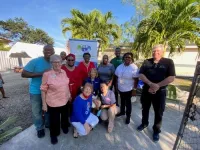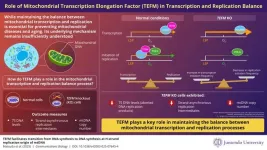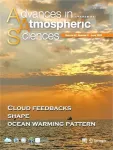To bridge this gap, researchers from Florida Atlantic University’s Christine E. Lynn College of Nursing, and collaborators, implemented a pilot study to test an intergenerational program involving high school students, older adults and local faith-based health educators in the “Glades,” a rural community nestled at the southern tip of Lake Okeechobee in South Central Florida.
Older residents in this tight-knit community share a strong desire to maintain healthy habits that support aging in place. However, their ability to track and monitor these habits using wireless fitness devices like Fitbits and smartwatches is hindered by the area’s limited resources and the difficulties many residents have with mobile technology literacy.
The impetus for the community-driven study in this under-resourced area was for older residents (ages 53 to 84) to embrace technology and gain greater acceptance and use of health-tracking devices as well as assessing everyday brain health behaviors.
For the study, an ecological momentary assessment (EMA) was used to deliver health-related survey questions via a smartwatch four times a day asking questions like “In the past two hours, how much social contact have you had?,” “How physically active have you been?” and “How mentally engaged have you been?” In addition, paper-and-pencil assessments were used to screen for cognition, health literacy and technology competence. Researchers explored the relationships between these screening measures and the usage of the smartwatch.
Results, published in the journal Educational Gerontology, showed that 91% of older adults engaged with the smartwatch prompts, with an overall response rate of 77.8%. Interestingly, response rates were not influenced by factors such as health literacy, technology self-efficacy, self-reported cognitive status, education, age or rural living. Additionally, social contact was found to be positively associated with physical activity, mental engagement and the perception of having a “sharp mind,” highlighting the importance of social engagement for brain health. The training process and the use of smartwatches proved effective for participants with varying levels of technology and health literacy.
“Our study created a win-win situation for everyone involved: older adults gained new skills in using wearable technology to monitor their health, while high school students had the opportunity to learn processes for conducting meaningful research and develop valuable skills,” said Lisa Ann Kirk Wiese, Ph.D., senior author and an associate professor, Christine E. Lynn College of Nursing. “Faith-based health educators, trusted figures within their communities, were able to contribute to the well-being of those they serve, fostering a sense of empowerment and connection across generations.”
For the study, participants wore the smartwatch for at least two weeks and received a simultaneous ringtone and vibration for each prompt. High school students (ages 15-19) trained participants on how to wear the smartwatch and respond to prompts using step-by-step guides. They assisted with setup, including charging the watch and understanding prompt timings, and offered additional support during follow-up visits.
Before participants began using the smartwatches, faith-based health educators administered surveys, with high school students often present. Participants also completed a brief cognitive screening (Borson’s Mini-Cog©), health literacy assessment, and a sociodemographic survey during the initial screening.
Students expressed gratitude for the opportunity to participate in a research initiative, with many seeking further research-related positions or scholarships. They valued the chance to add this experience to their resumes. All participants agreed they would likely never have used a smartwatch without the students’ guidance. Participants with more years of education expressed that wearing the smartwatch was particularly enjoyable and they were curious about their progress. For those with less education, more hands-on training was needed. Both students and older adults appreciated the time spent together, with students gaining valuable skills like teaching technology, patience and empathy. They also felt a sense of responsibility and open-mindedness.
“High school students don’t just teach older adults about mobile health – they also gain invaluable skills and insights themselves,” said Wiese. “Through these meaningful interactions, students discover how technology can improve health monitoring and care, while being inspired to pursue careers in aging, health care and gerontechnology. These experiences not only prepare them for future careers but also foster a deep appreciation for the power of digital health in their own lives.”
Through community-based participatory research, the FAU nurse-led team has collaborated with gatekeepers and stakeholders across the past 10 years to increase care of older adults in this region.
Study co-authors are Catherine Luna, Department of Psychology, Washington State University; Diane Cook, Ph.D., Regents Professor and Huie-Rogers Chair Professor, School of Electrical Engineering and Computer Science, Washington State University; Bryan D. Minor, Ph.D., associate in research, School of Electrical Engineering and Computer Science, Washington State University; and Marueen Schmitter-Edgecombe, Ph.D., Regents Professor, H.L. Eastlick Distinguished Professor, Department of Psychology, Washington State University.
This research was supported by the National Institute on Aging of the National Institutes of Health under award number R35 AG071451, and by the National Science Foundation under award number 1954372.
- FAU -
About Florida Atlantic University:
Florida Atlantic University, established in 1961, officially opened its doors in 1964 as the fifth public university in Florida. Today, Florida Atlantic serves more than 30,000 undergraduate and graduate students across six campuses located along the Southeast Florida coast. In recent years, the University has doubled its research expenditures and outpaced its peers in student achievement rates. Through the coexistence of access and excellence, Florida Atlantic embodies an innovative model where traditional achievement gaps vanish. Florida Atlantic is designated as a Hispanic-serving institution, ranked as a top public university by U.S. News & World Report, and holds the designation of “R1: Very High Research Spending and Doctorate Production” by the Carnegie Classification of Institutions of Higher Education. Florida Atlantic shares this status with less than 5% of the nearly 4,000 universities in the United States. For more information, visit www.fau.edu.
END








